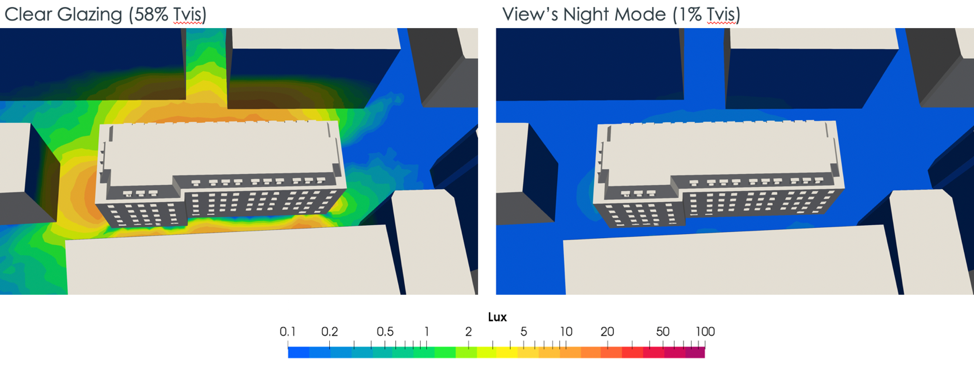
Going Dark – Night Mode Benefits People and Wildlife
Today we are familiar with discussions around air, water, and land pollution, but artificial light is also a pollutant. In the not-so-distant past, societies could look up and see the stars in the night sky. Today, in many areas, light pollution blocks that view. The risks of light spillage are more significant than just seeing the stars - it can have severe consequences for people and wildlife.
Light pollution shows up in three significant ways:
- Light trespass – light falling where it is not planned or needed
- Skyglow – brightening of the night sky over populated areas
- Glare – unnecessary brightness from buildings that can cause visual discomfort
Recently View conducted a study in a major urban area to measure the impact of light pollution. What we found was light spillage from the property was reduced by 98% when View’s smart windows were set to Tint 4 (the darkest tint). Urban areas are beginning to put requirements around new buildings and light spillage. For example, West Hollywood, CA has governance that states: “Outdoor lighting shall be designed to prevent glare, light trespass, and sky glow as much as possible. Permanently installed lighting shall not blink, flash, or be of unusually high intensity or brightness.”
 Exterior nighttime light spill before and after tinting.
Exterior nighttime light spill before and after tinting.
Furthermore, residents in mixed-use areas find they sleep better when light pollution is reduced. “Night mode” in View’s smart windows also provides security for individuals working in buildings by providing a higher level of obscuration vs. the use of blinds or shades. During periods of daylights savings time changes, or in Northern climates, this is important for the safety of individuals in the building.
For wildlife, evening light spillage increases are a danger. During migration on foggy nights or when the cloud base is low, bright light sources can cause nocturnal birds to circle in confusion and collide with structures, each other, or even the ground. The Audubon society states, “Many birds, particularly songbirds, migrate at night, navigating by the moon and stars. Mostly flying at altitudes below 2,000 feet, and even lower on foggy and rainy nights, they often become disoriented by brightly lit windows in tall buildings.” View’s smart windows, when set to their darkest tint, can prevent collisions while still meeting the occupant and security needs for the building.
This capability for View’s dynamic windows to be controlled and tinted offers a significant advantage over traditional façade solutions during the night. During daylight hours, View Dynamic Glass lets in the optimal amount of natural light and preserves views while blocking unwanted glare and heat.